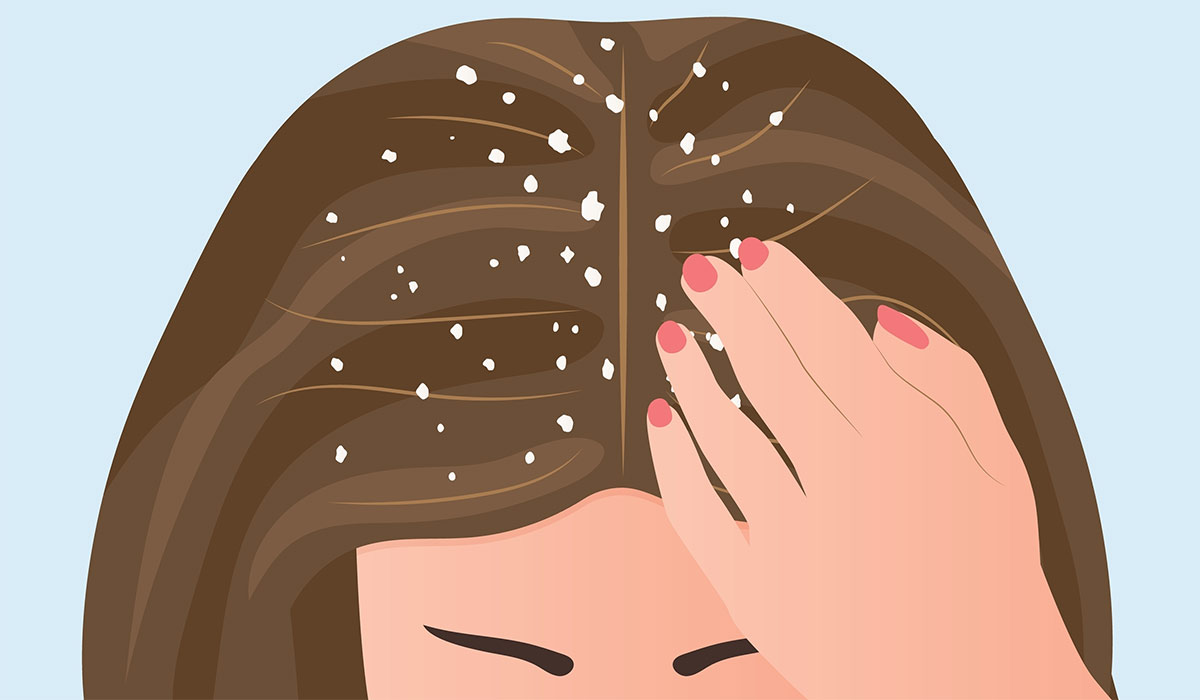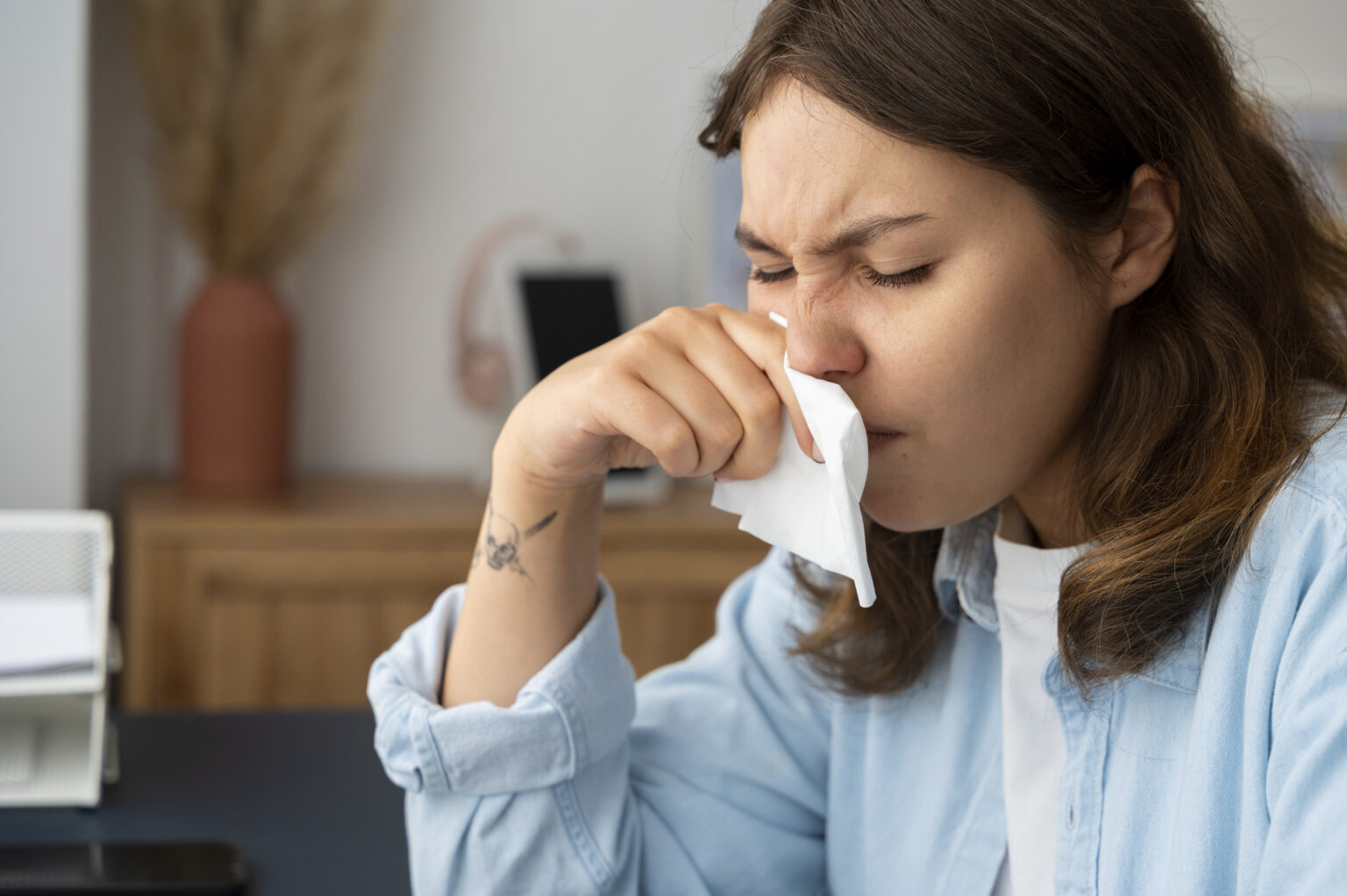
Green Mucus
A green mucus can indicate a viral or bacterial infection, sinusitis, bronchitis, or bronchiolitis. The green color is a result of immune cells. If you have a green runny nose for more than ten days, it’s important to seek medical advice.
Yellow Mucus
Yellow mucus is often present during viral infections such as colds, flu, and sinusitis. It can also signal a bacterial infection and may have an unpleasant odor.
Watery Mucus
Abundant, colorless, and watery nasal discharge may indicate allergic rhinitis. Then, a runny nose most often appears during the pollen season of allergenic plants and is the result of the release of the so-called inflammatory mediators, including histamine, which dilates the blood vessels of the nasal mucosa and increases their permeability.
Additionally, there is an itchy nose, watery and itchy eyes, and frequent sneezing. However, there is no increased body temperature characteristic of a cold. These symptoms disappear after cessation of contact with allergens. The exception is year-round allergic rhinitis when allergens are always present in the environment (e.g., house dust mites).
Colorless and watery nasal discharge may also indicate the early stages of acute rhinitis. It is caused by congestion and increased permeability of the blood vessels of the nasal mucosa. However, later, he changed his character again.
Thick And White Mucus
The runny nose may be thick and white during a viral and bacterial infection. Over time, the runny nose turns yellow or green under the influence of large numbers of leukocytes (cells of the immune system) that fight pathogens.
Mucus With Blood
Nasal discharge stained with blood could be a sign of more severe respiratory conditions like tuberculosis. However, it usually results from irritation of the nose lining and the bursting of blood vessels due to inflammation. The mucous membrane might also bleed if you frequently use nasal drops, for example, when dealing with a cold.
Causes
A runny nose is most often caused by a viral infection of the upper respiratory tract. These include:
- Rhinoviruses
- Coronaviruses
- Adenoviruses
A runny nose can also result from a bacterial infection (although this type is less common). You become infected with the so-called germs by droplets, for example, when someone near you sneezes. This way, one sick person can infect dozens of people.
Significant body cooling or overheating weakens the immune system, which also creates favorable conditions for viruses or pathogenic bacteria to enter through the nasal mucosa.
A runny nose may also be a symptom of hay fever. A runny nose, which is a symptom of a cold, is sometimes challenging to distinguish from an acute allergic reaction, e.g.:
- Flower pollen
- Animal dander
- House dust
It is worth remembering that allergic rhinitis often accompanies conjunctivitis and significant breathing difficulties but not increased temperature.
Remember that a runny nose, while inconvenient, actually helps the body fight infections. Sneezing and blowing your nose frequently with disposable tissues can help clear mucus and viruses from your respiratory tract. If you use nasal drops to shrink the nasal passages, limit use to 3-4 days. It’s best to use them when you’re unwell or must go out.
Ironically, nasal drops can also cause a runny nose, known as drug-induced rhinitis. It occurs when decongestant drops are used for extended periods and dry out the mucous membrane, making it more susceptible to viral attacks.
Symptoms
Viral rhinitis is characterized by leakage of watery and mucous secretions, while bacterial rhinitis is characterized by mucopurulent secretion. The remaining local symptoms of the disease are similar: both the first and second symptoms manifest themselves as:
- Stuffy nose
- Swelling of the nasal turbinates
- Scratchy throat
Both types of runny nose may be accompanied by:
- Cough
- Headache
- The feeling of a general breakdown

The thickening secretion is difficult to remove and remains in the nasal cavities. The result is a feeling of the face expanding from the inside and a headache. A stuffy nose forces you to breathe through your mouth, which causes:
- Additional water loss
- Drying of the throat mucosa
- Obstruction of sinus openings and Eustachian tubes
- Smell disorders
Secondary bacterial infection is accompanied by:
- Change in nasal discharge (thickening)
- Color (greenness)
- Unpleasant smell (suppuration)
- Fever
In the case of allergic rhinitis, caused by allergic agents (allergens), most often inhaled ones, causing an inflammatory reaction in the mucous membrane, in addition to the feeling of stuffy nose and watery discharge, there are also:
- Nose itching
- Sneezing
- Watery eyes
How Long Does It Last?
The runny nose lasts on average about 7 days, but 14-day colds also occur. Typically, symptoms usually disappear within 2 to 7 days.
A persistent runny nose, or chronic runny nose, lasts continuously or repeats itself in the form of attacks. If you have a chronic runny nose, see a specialist to diagnose it. Most often, it is related to sinus disease, allergy, or vasomotor disorders. However, it may signal a serious illness, even cancer.
Chronic runny nose often plagues people suffering from circulatory diseases, liver and kidney diseases, and diabetes. Hormonal disorders may also cause chronic runny nose—that’s why it often bothers pregnant women. Vitamin A deficiency will also contribute to chronic catarrh.
Home Remedies
Many people believe that a cold needs to run its course. However, in reality, it’s important to address rhinitis promptly. The idea that treated or untreated colds last only a week is false. Rhinitis affects more and more people throughout the year.
In addition to taking fever-reducing, anti-inflammatory, and possibly pain-relieving medications, patients must clear their nasal passages as soon as possible.
When the nose is blocked, it creates ideal, oxygen-deprived conditions for bacterial infections to develop. Additionally, the mucus in the nose hinders the movement of the tiny hair-like structures (cilia) that help transport and remove the mucus.
Ways to deal with a runny nose induce treatment methods like:
- Lubricate the wings of the nose with a vitamin ointment or a protective cream to relieve skin irritation
- Drink plenty of fluids (it thins the secretions and makes the nose easier to clean)
- Eat hot, steaming foods (e.g., broth) and drink plenty of tea with raspberries, elderberry juice, or cistus tea
- Add garlic to sandwiches because it has a strong antibacterial effect. For dinner, make a sandwich with finely chopped parsley (it contains a lot of vitamin C), butter, and a crushed clove of garlic
- Also remember to wash your hands frequently, especially after cleaning your nose with a disposable tissue
- When fighting a cold, people often use increased doses of vitamin C and regular preparations (2-3 times a day, 3-4 tablets). While they won’t eliminate a runny nose or cure a cold, they help seal and strengthen the blood vessel walls in the nasal mucosa, weakened by the infection. It’s also beneficial to take calcium preparations (Calcium C), even though these may cause excessive drying of the nasal mucosa
Tablets For Colds
There is no single effective medicine for a cold. But runny nose tablets will help in clearing a blocked nose. You can also use nasal drops, which reduce swelling and blood supply to the nasal mucosa. Remember that nasal drops should not be overused. Use them for no longer than 3-4 days.
Remember About Rutin
Inflammation in the nose increases the permeability of the mucosal blood vessel walls. This causes fluids from the blood plasma to leak out, creating a watery runny nose, commonly known as a runny nose. Therefore, for the first symptoms of a runny nose, start taking vitamin C, rutin, and calcium preparation – this will seal the blood vessels.
Nose Hygiene
It is believed that disposable wipes are more hygienic as they can be used once and then discarded, ensuring that any secretions, viruses, and bacteria from the upper respiratory tract are disposed of. In contrast, when using a cotton handkerchief, microorganisms from blowing your nose can linger and are only eliminated when the handkerchief is washed at a temperature exceeding 70 degrees Celsius.
To avoid ear infections, it’s best not to blow too hard or clean both nostrils simultaneously. Instead, press one nostril with your fingers and blow, then repeat the process for the other nostril. If constant wiping causes discomfort, apply healing ointment with vitamin A to the nostrils.
Nasal Drops
Many people struggle with runny noses in the fall and winter when it’s chilly and windy. One quick way to find relief is to use nasal drops, but it’s important to choose the right kind. For allergic and viral colds, go for drops that constrict blood vessels. If your runny nose is due to sinus inflammation, opt for drops that help loosen secretions. For a bacterial runny nose, consider using antibiotic or sulfonamide drops.
It’s crucial to use drops only when necessary. During the first 2-3 days of a cold, you can use them more frequently and then less often over the following 2-3 days, following the manufacturer’s instructions whenever possible.
Overuse of the drops causes chronic swelling and dryness of the mucous membrane and, after a long time, even atrophy of the mucous membrane. A sure solution to the situation is “nasal drops” in tablets. The pseudoephedrine in them reduces the congestion of the mucous membranes, eliminating swelling and reducing the amount of nasal discharge. Tablets used to treat flu and colds also contain the same ingredient.
Inhalations With Essential Oils
Home remedies for colds may also be effective, for example, inhalations with essential oils such as peppermint, peppermint, juniper, or thyme oil. Some specialists suggest that you can also use ready-made preparations. They open the respiratory tract and bring relief only for a moment, but they do not solve anything in the long run. Essential oils disinfect the nose locally (but only weakly) and make it easier to breathe, but later, they may even worsen a runny nose.
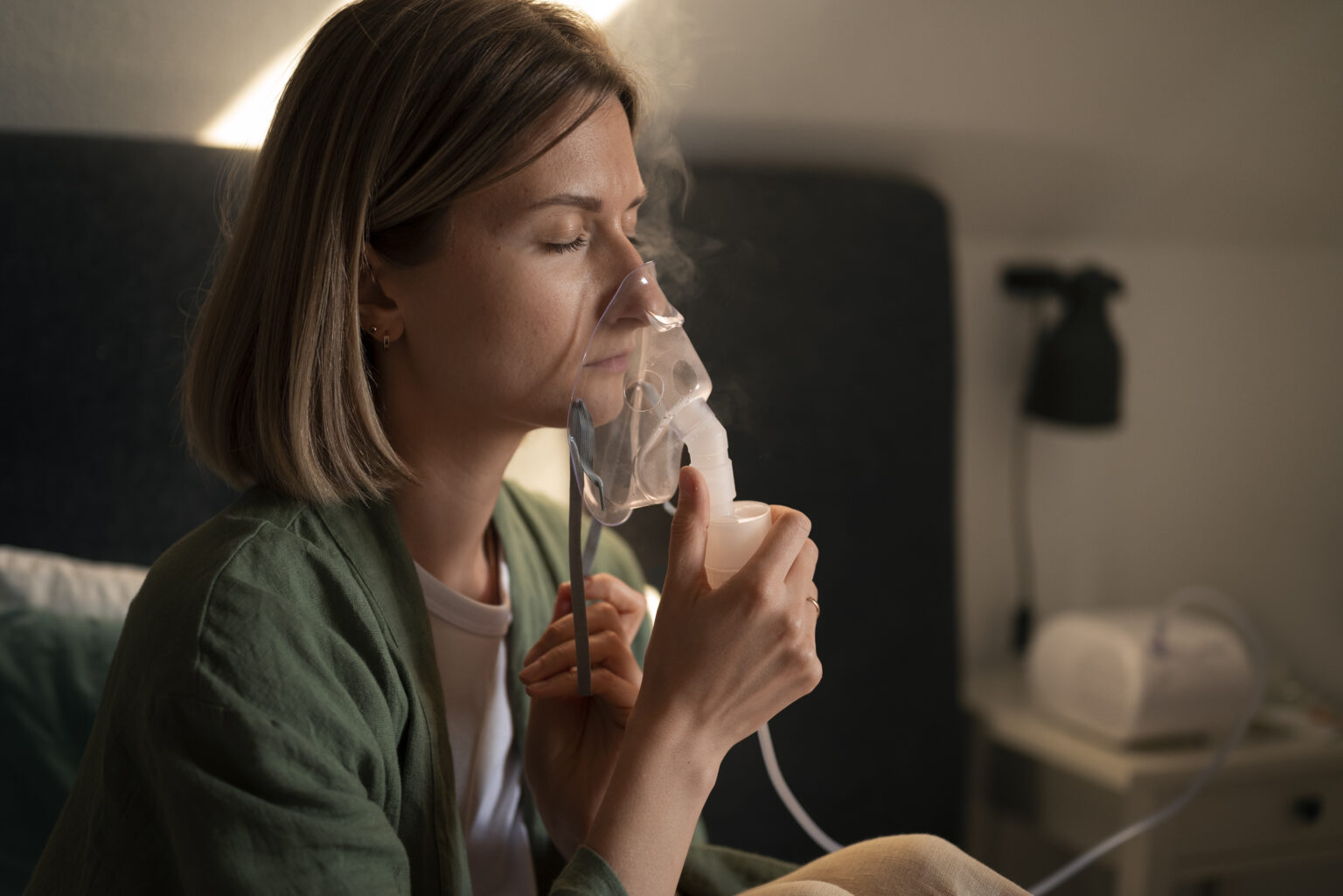
Seawater
When you have a runny nose, it is worth moisturizing the mucous membranes in your nose with an isotonic seawater solution. This type of preparation will also bring relief when the mucous membranes are dried by air conditioning, central heating, or staying in rooms where cigarettes are smoked.
Sea salt solutions can then be helpful – they act on the mucous membranes like a broom, cleansing them of allergens and impurities, and at the same time covering them with a thin layer of a protective substance that moisturizes the inside of the nose so we can breathe freely. An effective way to deal with a runny nose is also warm inhalations with sea salt – pour 2 tablespoons of salt into a pot pour a glass of water, heat it, and inhale the warm (not hot!) steam through your nose. Repeat the treatment 3-4 times a day.
During Pregnancy
A runny nose during pregnancy may be caused by infection, allergy, or hormonal changes. If the cause is high estrogen and progesterone levels, a persistent runny nose goes away after giving birth. However, if the cause is an infection or allergy, consult a doctor and select the optimal treatment that will not affect the development of the fetus. A runny nose during pregnancy does not threaten the baby, but the development of infection may hurt the course of pregnancy.
In Children And Infants
A runny nose in babies or a runny nose in children is a real nuisance for parents. it can be dangerous for newborns, infants, and children up to two years of age. It makes breathing, swallowing, and sucking difficult and is easily transmitted through the eustachian tube, causing inflammation of the ears and, consequently, hearing loss.
Also, in older children and adults, an untreated runny nose can cause more serious health complications: it can become chronic, cause inflammation of the sinuses and ears, or lead to more serious complications, such as bronchitis and pneumonia.
Complications
A runny nose may be the beginning of an infection. Go to the doctor if you have muscle, joint, headache pain, a temperature exceeding 38 degrees Celsius, and a runny nose. These may be the first signs of flu.
A runny nose, accompanied by severe headache, the feeling of pressure around the cheeks, temples, or bridge of the nose, and purulent, requires consultation with a doctor. You may have sinusitis, and this requires specialized treatment.
Sources
- Review of Rhinitis: Classification, Types, Pathophysiology. NIH.
https://www.ncbi.nlm.nih.gov/pmc/articles/PMC8303640/ - Viral and bacterial rhinitis. NIH.
https://pubmed.ncbi.nlm.nih.gov/17153013/ - Allergic rhinitis. NHS.
https://www.nhs.uk/conditions/allergic-rhinitis/ - Rhinitis. NIH.
https://www.ncbi.nlm.nih.gov/pmc/articles/PMC7119310/ - Management of Rhinitis: Allergic and Non-Allergic. NIH.
https://www.ncbi.nlm.nih.gov/pmc/articles/PMC3121056/ - Protective effects of rutin through regulation of vascular endothelial growth factor in allergic rhinitis. NIH.
https://pubmed.ncbi.nlm.nih.gov/25975244/ - Effectiveness of Over-The-Counter Intranasal Preparations: A Randomized Trial. NIH.
https://www.ncbi.nlm.nih.gov/pmc/articles/PMC6848630/ - The Role of Seawater and Saline Solutions in Treatment of Upper Respiratory Conditions. NIH.
https://www.ncbi.nlm.nih.gov/pmc/articles/PMC9147352/ - Rhinitis as a cause of respiratory disorders during pregnancy. NIH.
https://pubmed.ncbi.nlm.nih.gov/22826069/



